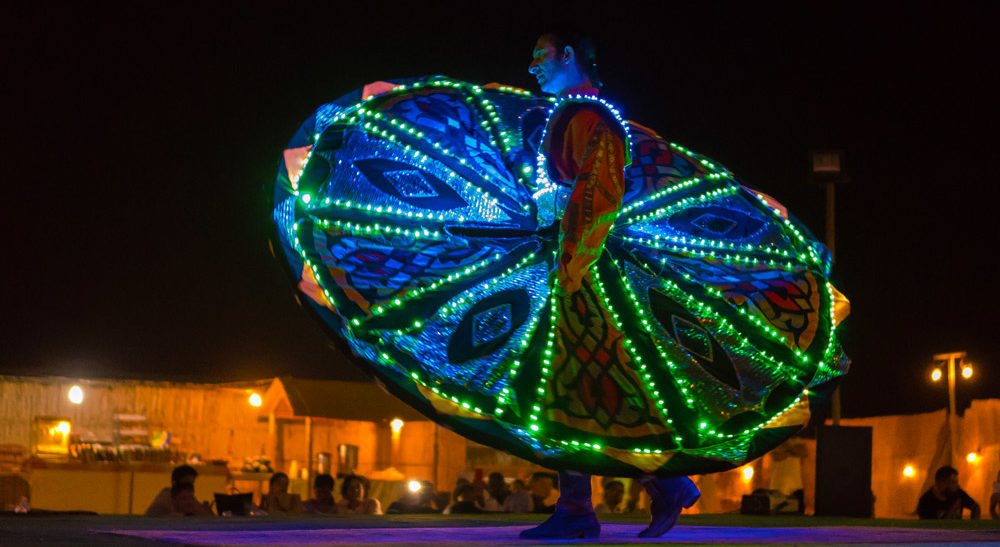Photo via NS Dancing Dance Studio
As I watch the bellydancer leave the hall, and turn to my cousins to comment on her performance and flashy costume, I notice another performer walking in and settling at the center of the hall.
“It’s the Tanoura!” we blurt out happily, instantly recognizing him.
In a huge colorful skirt with lights attached to it, trousers below, and a white skullcap, the young man began to spin to the tunes of the Arabic song ‘Doury Beena’ (Spin Us Around) alongside the sound of rhythmic claps from the audience.
As the layers of the skirts spun and the performance went on, we saw the Tanoura dancer remove one skirt, fold it and hold it in his arms as if it’s a baby. Right before the end of his performance, the dancer removed one layer of the skirts, spinning it over his head, moving from one table to another to spin the skirt over the audience’s heads. I later learnt that some believe it is symbolic of the Almighty showering the attendees with blessings.
As he continued to spin effortlessly, my mind traveled far, wondering about the origin of this dance that counts as one of the most popular Egyptian folkloric dances today.

Photo via Oasis Palm Tourism
Tanoura is an Arabic word, which translates to skirt in English. It is a traditional folk dance in Egypt, where the dancer spins to the tunes of Arabic songs, sometimes religious ones, too, known as Tawasheeh (a mix of Quranic verses and classic poetry). If the dance is performed according to spiritual association, he would be spinning anti-clockwise, symbolising Muslim pilgrimage around the Ka’aba. If it’s for entertainment purposes, he could spin clockwise or counter-clockwise. The Tanoura is a unique dance that is often seen as philosophical or even religious, taking the dancer to new spiritual levels.
Many historians say that the Tanoura dance was first introduced by Turkish philosopher and poet Jalal al-Din al-Rumi, and that it came to Egypt in the 14th century. Jalal al-Din al-Rumi was a renowned Sufi scholar in the 13th century, and is believed to have been the first Tanoura dancer during the Fatimid era. At the time, the dance was limited to the Sufi community. Today, it is performed by non-Sufis as well.
Some say that the Tanoura can be described as an evolved depiction of the Sufi Whirling Dervishes, a major part of Sufism, known for its mysticism and spiritual way of worship. Sufi Whirling is a physical act of meditation where Sufis spin until they reach a level of religious ecstasy. They wear long white robes and perform in groups, unlike Tanoura’s solo performance. Many say that with the passing of time, Egyptians made additions to the Tanoura dance to make it more entertaining and fun, by adding tambourines, colours, lights, and music that is not necessarily religious.

Photo via AP
Unlike most dances, which are primarily performed by women, this dance is only performed by men. Whether in a desert safari, a Nile cruise, a religious festival or al-mawlid al-nabawi (annual celebration of the Prophet Mohamed’s birthday), the Tanoura is always a main part of the event lineup. So if you are visiting Egypt and are planning to attend a religious festival or a cultural event, make sure to not miss the exceptional Tanoura performance.
Fun fact: One skirt worn by the Tanoura dancer can weigh up to 15 kilograms, and Tanoura dancers perform wearing three skirts, if not more.
Subscribe to the Egyptian Streets’ weekly newsletter! Catch up on the latest news, arts & culture headlines, exclusive features and more stories that matter, delivered straight to your inbox by clicking here.







Comments (8)
[…] Source: https://egyptianstreets.com/2021/10/03/spinning-away-the-origin-of-egypts-folkloric-tanoura-dance/ […]
[…] Read more @ egyptianstreets.com […]